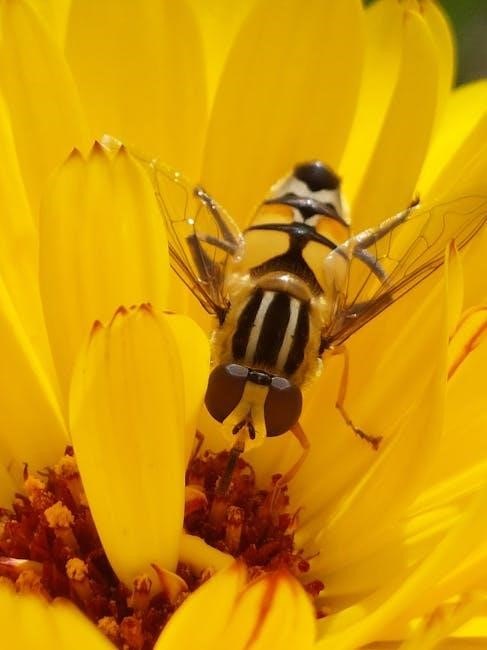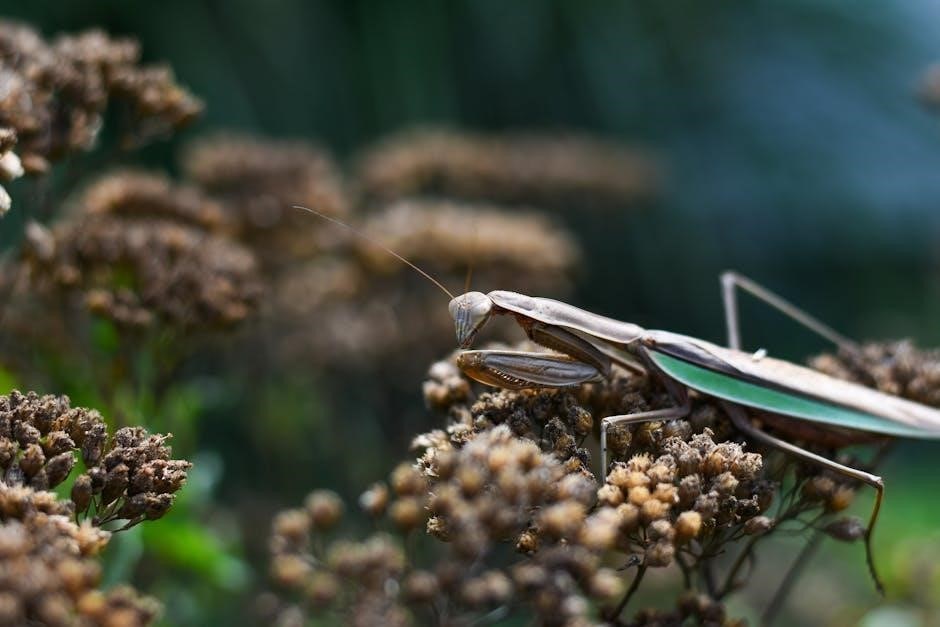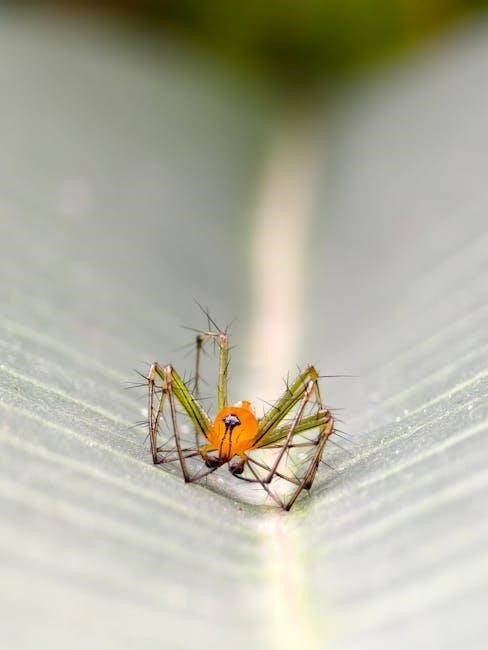Insect field guides are essential tools for identifying and understanding insect species, offering detailed descriptions, high-quality images, and practical information for enthusiasts and researchers alike.
1.1 What is an Insect Field Guide?
An insect field guide is a comprehensive resource designed to help identify and understand insect species. These guides typically include detailed descriptions, high-quality images, and classification information about various insect orders and families. They often feature durable bindings for outdoor use and user-friendly systems to aid in quick identification. Popular guides, such as the Peterson Field Guide to Insects and the National Audubon Society Field Guide, provide essential tools for enthusiasts, researchers, and educators. They serve as invaluable companions for exploring the diverse world of insects, making complex information accessible to all skill levels.
1.2 Importance of Using Field Guides for Insect Identification
Field guides are indispensable for accurate insect identification, offering detailed descriptions and images that simplify recognizing species. They empower enthusiasts and professionals alike to expand their knowledge, fostering a deeper appreciation for entomology. By providing accessible information, these guides bridge the gap between scientific complexity and everyday observation. They also serve as vital educational tools, encouraging learning and conservation efforts. Whether for research or casual exploration, field guides are essential for understanding insect diversity and their ecological roles, making them a cornerstone of both amateur and professional insect study.

Essential Features of a Good Insect Field Guide
A good insect field guide should include detailed descriptions, high-quality images, durable binding, and user-friendly systems for easy identification and reference in the field.
2.1 Detailed Descriptions of Insect Orders and Families
Detailed descriptions of insect orders and families are crucial for accurate identification. Field guides provide taxonomic classifications, life cycles, and ecological roles, aiding enthusiasts and researchers. They cover physical traits, behaviors, and habitats, ensuring comprehensive understanding. This information helps users distinguish between similar species and appreciate their biological significance. By organizing data hierarchically, guides make complex entomological knowledge accessible. Such descriptions are vital for both fieldwork and deeper scientific study, offering a foundation for further exploration and learning about insects.
2.2 High-Quality Color Photographs and Illustrations
High-quality color photographs and illustrations are indispensable in insect field guides, enabling precise identification. Vibrant images capture the intricate details of species, such as color patterns, shapes, and textures. These visuals help distinguish similar species and highlight key diagnostic features. Illustrations often complement photos by emphasizing specific traits or life stages. For example, the National Audubon Society Field Guide features over 700 full-color photographs organized by color and shape, while the Kaufman Field Guide includes detailed images that aid in recognizing insect behaviors and habitats. Such visual aids are essential for both novice and experienced entomologists, enhancing the accuracy and efficiency of field identification.
2.3 Durable Binding for Field Use
A durable binding is a critical feature of insect field guides, ensuring they withstand frequent outdoor use. Guides like the Peterson Field Guide to Insects feature tough, lightweight covers designed for repeated handling in the field. The National Audubon Society Field Guide uses a durable vinyl binding to resist wear and tear. Such materials are essential for withstanding the rigors of fieldwork, such as moisture, dirt, and heavy use. A well-constructed binding ensures the guide remains a reliable companion for entomologists and nature enthusiasts, maintaining its integrity over time and numerous adventures.

2.4 User-Friendly Identification Systems
User-friendly identification systems are a hallmark of effective insect field guides. The Peterson Field Guide series employs a unique method that simplifies insect recognition through clear descriptions and visual cues. The National Audubon Society Field Guide organizes insects by color and shape, making identification intuitive. Similarly, the Kaufman Field Guide uses an ecological approach, focusing on observable behaviors and life histories. These systems ensure that even novice enthusiasts can accurately identify species without prior expertise. By combining accessibility with accuracy, these guides empower users to deepen their understanding of insect diversity in the field.

Popular Insect Field Guides
Popular insect field guides include the Peterson Field Guide, National Audubon Society Field Guide, and Kaufman Field Guide, each offering unique features for insect enthusiasts and researchers.
3.1 Peterson Field Guide to Insects
The Peterson Field Guide to Insects is a landmark resource, renowned for its detailed descriptions of insect orders, families, and species. It features the unique Peterson identification system, which is highly praised for its ease of use and accuracy. The guide is designed for both beginners and experts, offering comprehensive information on insect behavior, habitat, and life cycles. Its durable, lightweight cover ensures longevity for frequent field use. With a focus on North American species, this guide remains a trusted companion for entomologists and nature enthusiasts, providing essential insights into the fascinating world of insects.

3.2 National Audubon Society Field Guide to Insects and Spiders
The National Audubon Society Field Guide to Insects and Spiders is a comprehensive resource, featuring over 700 full-color photographs organized by color and shape for easy identification. Its durable vinyl binding makes it ideal for field use. The guide covers a wide range of species across North America, providing detailed descriptions of insects and spiders, their habitats, and behaviors. This must-have guide is perfect for enthusiasts and researchers, offering a wealth of information that enhances understanding and appreciation of these often-overlooked creatures.

3.3 Kaufman Field Guide to Insects of North America
The Kaufman Field Guide to Insects of North America is a highly regarded resource, praised for its comprehensive coverage of insect species. It features detailed descriptions, vibrant color photographs, and insights into insect biology and life histories. Kenn Kaufman’s ecological approach makes the guide accessible to both beginners and experts. The guide’s focus on observable behaviors and habitats enhances field identification. With its user-friendly design, it is an indispensable tool for anyone exploring North America’s insect diversity, offering a deeper understanding of these fascinating creatures and their roles in the ecosystem.
3.4 Other Recommended Guides for Specific Regions
Regional insect field guides cater to specific geographic areas, offering localized insights and species identification. For example, the Field Guide to the Flower Flies of Northeastern North America focuses on a particular group in a defined region. Similarly, guides like Dragonflies and Damselflies of Texas provide targeted information, enhancing accuracy for local enthusiasts. These specialized guides often include detailed photographs and ecological notes, making them invaluable for researchers and hobbyists alike. They complement broader guides by addressing unique biodiversity and ensuring precise identification within specific areas, fostering a deeper connection with local insect communities.
How to Choose the Right Insect Field Guide
Assess your needs, consider your geographic region, and match your expertise level. Ensure the guide is updated, durable, and features clear identification systems for effective use.
4.1 Consider Your Geographic Region
Choosing an insect field guide tailored to your geographic region ensures relevance and accuracy. Guides specific to areas like North America, Europe, or the Northeast often cover local species. For instance, the Kaufman Field Guide is ideal for North America, while the Royal Entomological Society’s Handbooks are excellent for Britain and Ireland. Regional guides provide detailed insights into local habitats, making identification more precise. Always verify the guide’s coverage area to match your exploration zone, enhancing your ability to recognize and study insects effectively in your environment.
4.2 Determine Your Level of Expertise
Choosing an insect field guide that matches your expertise level ensures a rewarding experience. Beginners benefit from guides with simple language, like the National Audubon Society Field Guide, which uses visual organization by color and shape. Intermediate learners may prefer guides like the Kaufman Field Guide, offering detailed life cycles and behaviors. Advanced users might opt for technical guides with ecological insights. Selecting a guide aligned with your knowledge level enhances learning and identification accuracy, making entomology accessible and engaging for everyone, from casual observers to seasoned experts.
4.3 Look for Guides with Updated Information
When selecting an insect field guide, prioritize those with recent updates to ensure accuracy and relevance. Taxonomy and species classifications frequently evolve, and outdated guides may lead to misidentification. Updated guides incorporate the latest research, such as new species discoveries and revised classifications. For example, the Kaufman Field Guide and Peterson Field Guide are regularly revised to reflect current scientific understanding. Updated photography and life history details also enhance identification accuracy. Always check publication dates or revised editions to ensure you have the most reliable and up-to-date information for your insect identification needs.
Trusted Authors and Their Contributions
Renowned authors like Eric R. Eaton and Kenn Kaufman bring expertise to insect field guides, offering accessible, accurate, and engaging information for enthusiasts and scientists alike.
5.1 Eric R. Eaton and His Expertise in Entomology
Eric R. Eaton, a distinguished writer and naturalist, has dedicated his career to the study of insects, blending professional entomology experience with engaging storytelling. Known for his accessible style, Eaton has contributed to popular magazines and authored works like Insectpedia, making insect identification approachable for all. His expertise shines in field guides, where he emphasizes observation, behavior, and ecology. Eaton’s work bridges the gap between scientific accuracy and reader-friendly content, inspiring both novices and experts to explore the fascinating world of insects with curiosity and depth.
5.2 Kenn Kaufman’s Ecological Approach to Insect Identification
Kenn Kaufman, a renowned naturalist and author, brings an ecological perspective to insect identification, emphasizing habitat, behavior, and life cycles. His field guides, such as the Kaufman Field Guide to Insects of North America, are celebrated for their comprehensive coverage and accessible language. Kaufman’s approach avoids overly technical terms, making it easier for readers to connect with insects through observation and understanding their roles in ecosystems. His work has significantly contributed to popularizing insect study, encouraging a deeper appreciation for these vital creatures and their ecological importance. Kaufman’s guides are both informative and inspiring, catering to experts and amateurs alike.
5.3 Other Notable Authors in the Field
is a foundational text, offering detailed keys for identification. Jeffrey Skevington and Michelle Locke are known for their specialized guides on flower flies. Paul T. Harding and Bev Seddon have authored works focusing on freshwater insects, providing essential insights for aquatic entomology. These authors collectively expand the scope of insect field guides, catering to diverse interests and expertise levels while advancing the field of entomology through accessible and comprehensive resources.
Digital Tools and Apps for Insect Identification
Digital tools like BugGuide.net offer comprehensive databases for insect identification, while mobile apps provide instant field recognition, enhancing traditional guides with advanced search and image recognition features.
6.1 BugGuide.net as a Comprehensive Online Resource

BugGuide.net is a leading online resource for insect identification, offering an extensive database of images, descriptions, and information on North American species. It allows users to submit photos for expert verification, fostering a community-driven approach to entomology. The platform is particularly valuable for its detailed coverage of insect morphology, life cycles, and habitats. With contributions from both professionals and enthusiasts, BugGuide.net serves as a reliable complement to traditional field guides, providing instant access to a vast array of species information and aiding in accurate identifications.
6.2 Apps for Quick Field Identification
Apps like the National Audubon Society Field Guide to Insects and iNaturalist revolutionize insect identification by offering portable, user-friendly tools. These apps feature comprehensive databases with high-quality images and detailed descriptions, enabling quick species recognition in the field. Users can upload photos or descriptions for instant identification, leveraging community contributions and expert insights. Such apps are particularly useful for rapid identification, combining convenience with accuracy. They complement traditional guides by providing real-time updates and interactive learning, making them indispensable for modern entomology enthusiasts and researchers alike.
6.3 Comparison of Digital vs. Traditional Field Guides
Digital and traditional field guides offer distinct advantages for insect identification. Digital guides provide portability, real-time updates, and interactive features like photo uploads and community insights, enhancing convenience. Traditional guides excel with detailed descriptions, high-quality images, and tactile ease of use. While digital tools are ideal for quick identifications, traditional guides often provide deeper ecological context and comprehensive species coverage. Both formats cater to different user preferences, with digital appealing to tech-savvy enthusiasts and traditional suiting those who value thorough, hands-on reference materials. Together, they complement each other, offering a holistic approach to insect study.
Tips for Using an Insect Field Guide Effectively
Observe insect behavior, habitat, and physical traits to narrow identification. Use color and shape for quick reference, and record observations for future study and accuracy.
7.1 Observing Insect Behavior and Habitat
Observing insect behavior and habitat is crucial for effective identification. Note the insect’s activity, such as feeding or flying patterns, and its preferred environment, like flowers or trees. Habitat clues, like whether an insect is found in wetlands or forests, can narrow down possibilities. Behavior observations, such as social interactions or nesting habits, provide additional context. Combining these details with field guide information enhances accuracy and deepens understanding of insect ecology and diversity.
7.2 Using Color and Shape for Quick Identification
Color and shape are key visual cues for insect identification. Bright hues often signal specific behaviors or defenses, while distinctive shapes, like elongated bodies or enlarged mandibles, indicate evolutionary adaptations. Many field guides organize images by color and shape, allowing users to quickly narrow down possibilities. Pay attention to patterns, such as stripes or spots, and overall body proportions. These visual traits, combined with habitat observations, can lead to rapid and accurate identifications, especially for beginners. Always cross-reference these features with detailed descriptions to ensure precision and avoid misidentification. This approach streamlines the learning process for enthusiasts of all levels.
7.3 Recording Observations for Future Reference
Recording observations is a vital skill for insect enthusiasts, aiding in tracking species behavior and habitats over time. Use notebooks or apps to document insect sightings, noting the date, time, location, and habitat. Include sketches or photographs to capture identifying features, such as color patterns or antennae shapes. Detailed notes help refine identification skills and provide valuable data for personal or conservation efforts. Regularly reviewing these records can reveal seasonal trends or changes in insect populations, fostering a deeper understanding of ecosystems and inspiring further exploration and learning in the field.

Insect Field Guides for Children and Education
Insect field guides for children are designed to make learning fun and interactive, often featuring colorful pictures, simple language, and engaging activities to spark curiosity about insects and nature.

8.1 Field Guides Designed for Young Naturalists
Field guides tailored for children are crafted to inspire curiosity and wonder, featuring vibrant imagery, simple language, and engaging activities. These guides often include fun facts, quizzes, and puzzles to make learning interactive. They focus on common, easily observable insects, helping kids develop observation skills and a connection to nature. Some guides, like I Spy Backyard Bugs, use guessing games to involve young learners. Others, such as The Butterflies of Cascadia, offer age-appropriate introductions to specific insect groups. These tools not only educate but also foster a sense of adventure, encouraging kids to explore and appreciate the natural world around them.
8.2 Interactive and Engaging Learning Tools
Interactive learning tools, such as apps, flashcards, and online platforms, enhance the educational experience for young naturalists. Apps like BugGuide.net offer visual identification aids and quizzes, making insect exploration fun and hands-on. Flashcards, such as those in Macs Field Guides, provide quick, portable learning opportunities. These tools incorporate gamification, fostering curiosity and engagement. They also cater to different learning styles, combining visual, tactile, and digital elements. By leveraging technology and creative design, these resources make insect study accessible and enjoyable, encouraging kids to explore and learn about the natural world in a dynamic, interactive way.
8.3 Encouraging STEM Education Through Insect Study
Insect field guides play a vital role in fostering STEM education by encouraging scientific observation, critical thinking, and hands-on learning. Studying insects introduces students to biology, ecology, and environmental science, while identification processes develop analytical skills. The use of field guides teaches systematic observation, classification, and data recording, aligning with scientific methodologies. Interactive tools and apps further integrate technology, enhancing engagement and learning. By exploring insect life cycles, habitats, and behaviors, students gain a deeper understanding of natural systems, promoting curiosity and a foundation for future STEM careers.

The Role of Field Guides in Conservation Efforts
Insect field guides aid conservation by identifying invasive species, monitoring biodiversity, and educating the public about insect importance, fostering environmental awareness and action.
9.1 Identifying Invasive Species
Insect field guides play a crucial role in identifying invasive species by providing detailed descriptions and images. This helps researchers and the public distinguish harmful insects from native ones. Early detection is vital for preventing ecological damage. Guides often highlight invasive species’ characteristics, such as unusual markings or behaviors. For example, the emerald ash borer, a highly destructive insect, is frequently featured in field guides to aid in its identification. By enabling quick and accurate recognition, these resources support conservation efforts and protect biodiversity. Collaborative efforts between experts and the public enhance monitoring and management strategies effectively.
9.2 Monitoring Biodiversity
Insect field guides are indispensable for monitoring biodiversity, as they provide detailed information on species distribution, behavior, and life cycles. By documenting insect populations, these guides help researchers track trends and identify declines. They often include habitat preferences and ecological roles, enabling a broader understanding of ecosystem health. Field guides also empower citizens and scientists to contribute to biodiversity surveys, fostering collaborative conservation efforts. Their comprehensive data supports the development of targeted strategies to protect vulnerable species and maintain ecological balance, making them a cornerstone of biodiversity monitoring initiatives worldwide.
9.3 Educating the Public About Insect Importance
Insect field guides play a crucial role in educating the public about the significance of insects in ecosystems. By providing accessible information on insect behaviors, roles, and ecological importance, these guides foster curiosity and appreciation. They often highlight how insects contribute to pollination, decomposition, and food chains. Field guides also serve as tools for outreach, helping to dispel myths and promote conservation. Their engaging presentations make complex scientific information understandable, inspiring people to value insects and support their protection. This education is vital for building a society that respects and preserves biodiversity.
Insect field guides have evolved significantly, offering detailed insights and fostering a deeper appreciation for entomology. Their role in education and exploration remains invaluable for learners of all levels.
10.1 The Ongoing Evolution of Insect Field Guides
Insect field guides are continually advancing, incorporating new discoveries, digital tools, and user-friendly designs. Enhanced with high-quality images and updated species information, they remain indispensable for researchers and enthusiasts. The integration of ecological insights and conservation tips reflects their growing role in education and environmental awareness. As technology progresses, these guides adapt, ensuring they stay relevant in a changing world, while trusted authors contribute expertise to maintain their reliability and accessibility for future generations of naturalists and scientists.
10.2 Encouraging Continued Exploration and Learning
Insect field guides inspire curiosity and a deeper appreciation for nature, motivating individuals to explore and learn about the diverse world of insects. By providing accessible information, these guides bridge the gap between professional entomologists and casual observers, fostering a sense of community among naturalists. They encourage ongoing discovery, as new species and behaviors are continually uncovered. Field guides not only educate but also inspire stewardship, promoting a lifelong journey of learning and appreciation for the vital role insects play in our ecosystem.